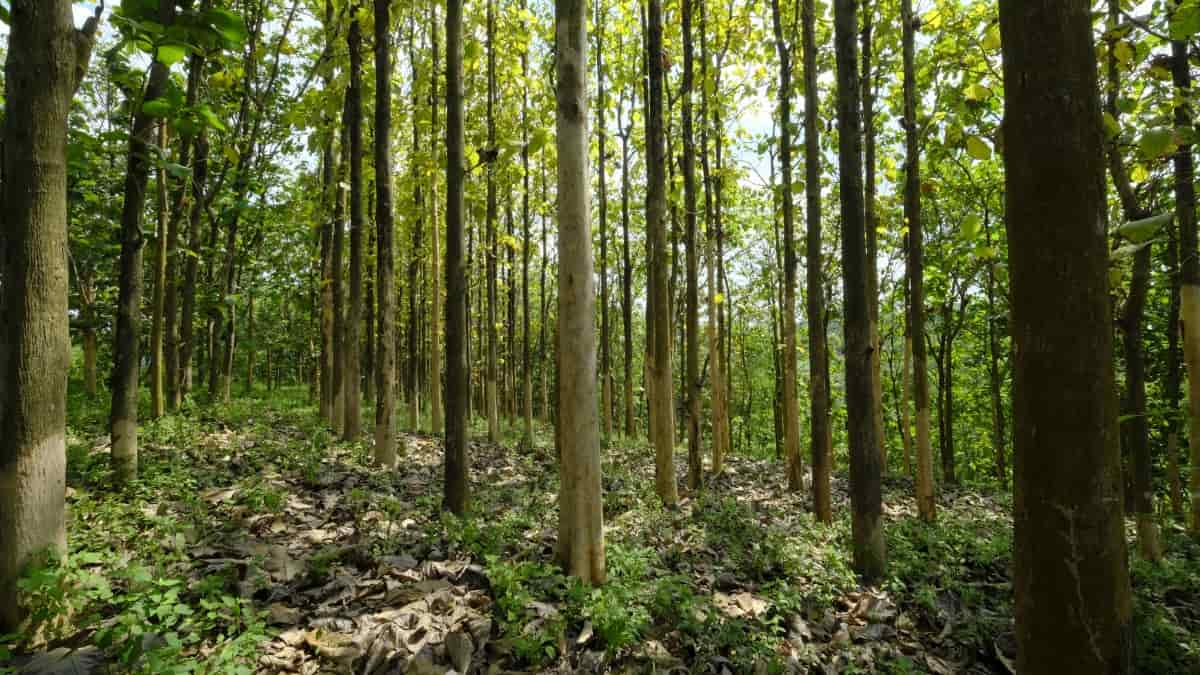Exploring the viability of a 1-acre Melia Dubia cultivation project, this report dives into the detailed economics, from initial costs to potential profits, in the context of Malabar Neem Farming in India.

1-Acre Melia Dubia Cultivation Project Report
Understand the Ideal Climate for Growing Melia Dubia
Melia Dubia, commonly known as Malabar Neem, thrives in a specific range of climatic conditions, crucial for its successful cultivation. This tree species, widely grown in various parts of India, including the western regions, demands a climate that balances between moderate to heavy rainfall and a fair share of sunlight. The optimal temperature range for Melia Dubia cultivation lies between 20°C and 40°C, making it suitable for most Indian climates.
It is resilient to variations in weather, but extremely cold and frost conditions can hinder its growth. Adequate rainfall is vital, especially during the initial growth phase, but the tree also exhibits tolerance to dry spells once established. Understanding these climatic needs is fundamental for anyone involved in a 1-acre Melia Dubia cultivation project report.
Select the Right Soil for Cultivating Melia Dubia
Soil selection plays a pivotal role in the successful cultivation of Melia Dubia. This important tree for Malabar Neem farming can grow in many types of soil, but it grows best in certain ideal conditions. An ideal soil for Melia Dubia cultivation is well-drained, fertile, and rich in organic matter. The pH value of the soil should ideally range from 6 to 8, indicating a neutral to slightly alkaline nature.
While Melia Dubia can tolerate slightly acidic soils, extreme acidity or alkalinity can hinder its growth. Loamy and red soils, commonly found in many parts of India, are particularly conducive to Melia Dubia’s growth. In preparing a 1-acre Melia Dubia cultivation project report, it is crucial to conduct a thorough soil test to ensure the land meets these requirements.
Seed Selection and Germination Techniques for Melia Dubia
The success of Melia Dubia cultivation begins with the right choice of seeds and their effective germination. High-quality seeds are fundamental in Malabar Neem farming, and selecting them requires careful attention. For a robust 1-acre Melia Dubia cultivation project report, identifying sources that provide healthy, disease-free seeds is vital.
Once the seeds are sourced, the germination process involves pre-sowing treatments like soaking them in water for 24 hours, which enhances the germination rate. The germination medium should be well-aerated and moist, ideally comprising a mix of soil, sand, and organic compost. The seeds are then sown at a shallow depth, ensuring they are not buried too deep, as this can affect sprouting. Consistent moisture and warmth are necessary for effective germination, typically taking about two to three weeks.
Best Practices for Planting Melia Dubia Saplings
Once the Melia Dubia seeds have successfully germinated, the next critical step in Malabar Neem farming is the planting of saplings. In a 1-acre Melia Dubia cultivation project report, outlining the best practices for planting is essential. The ideal time to plant Melia Dubia saplings is at the onset of the monsoon season, as the consistent rainfall aids in the initial growth.
The saplings should be planted in pits of appropriate size, roughly 45cm x 45cm x 45cm, to provide ample space for root development. It’s important to ensure proper spacing between the saplings, generally about 10 feet apart, to allow sufficient room for growth and to prevent overcrowding. Adding organic manure to the pits before planting the saplings provides a nutrient boost, aiding in healthier growth. Regular weeding and monitoring for pest attacks are also crucial in the early stages of growth.
Nutrient Management and Fertilization for Melia Dubia Trees
Effective nutrient management and fertilization are key components in ensuring the healthy growth and optimal yield of Melia Dubia trees. In a 1-acre Melia Dubia cultivation project report, a detailed plan for nutrient management is essential. Melia Dubia trees require a balanced supply of macro and micronutrients for robust growth. Initially, the application of organic manure, such as compost or farmyard manure, is recommended to enhance soil fertility.
In case you missed it: Cultivation Practices of Teakwood: Farming Steps and Number of Teakwood Plants Per Acre

As the trees grow, additional nutrients, especially nitrogen, phosphorus, and potassium, should be applied in appropriate proportions. The use of biofertilizers can also be beneficial, promoting soil health and aiding in the better absorption of nutrients. Regular soil testing is advised to monitor nutrient levels and to tailor fertilization practices accordingly.
Irrigation Strategies for Optimal Growth of Melia Dubia
Irrigation is a critical aspect of Malabar Neem farming, particularly in regions where rainfall is inconsistent. In a 1-acre Melia Dubia cultivation project report, outlining effective irrigation strategies is vital for the healthy growth of the trees. Melia Dubia requires regular watering, especially during the dry season, to maintain steady growth. The young saplings are more sensitive and need frequent watering, but as the trees mature, their watering needs decrease due to their deep root system.
Drip irrigation is highly recommended for Melia Dubia as it conserves water and delivers it directly to the root zone, reducing water wastage and preventing the growth of weeds. To grow Malabar Neem trees well and get good quality timber in contract farming, you need to water them just right. Don’t water too much because that can cause root rot and fungal problems. How much and how often you water should depend on the soil, weather, and how old the trees are.
How to Prune and Train Young Melia Dubia Trees
Pruning and training are essential practices in the cultivation of Melia Dubia, particularly in the early years of growth. These practices are emphasized in a 1-acre Melia Dubia cultivation project report for shaping the growth of the trees and improving their wood quality. Pruning helps in removing unwanted branches and promotes the growth of a straight and tall main stem, which is desirable for timber production.
The best time to start pruning is when the tree is about 2 to 3 years old. Initially, the focus should be on removing lower branches and any branches that are dead, diseased, or growing inward. As the trees grow, selective pruning can be done to shape the canopy and improve air circulation and sunlight penetration.
Training involves guiding the tree to grow in the desired shape and direction. This may include staking or tying young trees to ensure they grow straight. For those engaged in Malabar Neem contract farming, proper pruning, and training are crucial as they directly impact the quality of timber, which is a key factor for Malabar Neem buyers.
Economics and Project Report of Melia Dubia in 1-Acre Cultivation
Costs
Land Preparation
- Cost: ₹ 50,000 – ₹ 1,00,000
- Time: 1-2 months
Seedlings
- Cost: ₹ 20,000 – ₹ 30,000
- Time for Preparation: 1-2 months
Irrigation System
- Cost: ₹ 50,000 – ₹ 1,00,000
- Installation Time: 1-2 months
Fertilizers and Pesticides
- Cost: ₹ 20,000 – ₹ 30,000
- Application Frequency: 2-3 times a year
Labor Costs
- Cost: ₹ 50,000 – ₹ 1,00,000
- Time: 3-6 months (planting, maintenance, harvesting)
- Total Estimated Costs: ₹ 2,50,000 – ₹ 4,30,000
Profits
Sale of Timber
- Price per Tree: ₹ 500 – ₹ 1,000
- Total Revenue: ₹ 5,00,000 – ₹ 10,00,000 (1000 trees/acre)
Sale of Seedlings
- Price per Seedling: ₹ 50 – ₹ 100
- Total Revenue: ₹ 50,000 – ₹ 1,00,000 (1000 seedlings/acre)
Sale of Biomass
- Price per Ton: ₹ 2,000 – ₹ 3,000
- Total Revenue: ₹ 20,000 – ₹ 30,000 (10 tons/acre)
- Total Expected Profits: ₹ 7,50,000 – ₹ 14,30,000
In case you missed it: 1-Acre Agarwood Tree Farming Project Report: Costs, Profit, and Production Economics

Conclusion
This comprehensive analysis underscores that with careful planning and effective management, a 1-acre Melia Dubia cultivation in India can be a profitable venture, offering substantial returns for those engaged in Malabar Neem farming.
- Feed Your Flock for Less: Top 10 Tips to Save on Chicken Feed
- Ultimate Guide to Ossabaw Island Hog: Breeding, Raising, Diet, and Care
- Hatching Answers: The Top 10 Reasons Your Chickens Aren’t Laying Eggs
- Eggs and Economics: Breaking Down the Cost of Raising Backyard Chickens
- Defend Your Greens: Proven Methods to Keep Iguanas Out of Your Garden
- Ultimate Guide to Cinnamon Queen Chicken: A Comprehensive Guide for Beginners
- Ultimate Guide to California Tan Chicken: Breeding, Raising, Diet, Egg-Production and Care
- Ultimate Guide to Marsh Daisy Chicken: Breeding, Raising, Diet, and Care
- 10 Types of Chicken Farming Businesses You Can Start for Profits